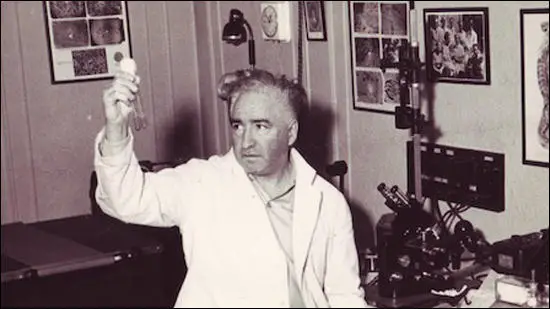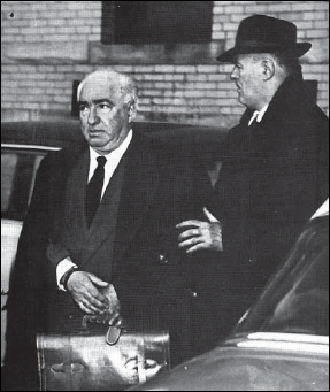Ilse Ollendorff

Ilse Ollendorff, the daughter of Georg Ollendorff and Margarete Ollendorff, was born in Breslau, Poland, on 13th March, 1909.
After a failed first marriage, Ollendorff emigrated to the United States. She met the psychologist, Wilhelm Reich, in October, 1939. Reich compared her to his previous girlfriend, Elsa Lindenberg, she is "clever, pretty, and she has a body that reminds me of Elsa, except that she is a brunette". (1)
Ollendorff later recalled her impression of him: "I was very much impressed by him, even a little awed... He was a striking figure with his gray hair, ruddy complexion, and white coat. He showed me the laboratory, the house, and invited me to have a glass of wine." (2) She added: "He was very stocky, and had a very red face because he had a skin disease... He was very attractive and out of the ordinary." (3) The couple began a passionate affair. Reich wrote in his journal that this brought an end to "six ghastly weeks of abstinence". (4)
Ollendorff became pregnant but he insisted she had an abortion because he feared a child would distract him from his research. They decided to live together and she became Reich's secretary and laboratory assistant. She was put in charge of the crates of cancerous mice that Reich was experimented on. "Reich was a hard taskmaster... The records had to be kept meticulously as to every detail of treatment... At times I had the feeling that our whole life was ruled by the stopwatch." (5)
In 1940 Reich built a box that he called an orgone accumulator. The earliest boxes were for laboratory animals, but later constructed a human-sized, five-foot-tall box that was set up in the basement of his house. It was made of plywood lined with rock wool and sheet iron, and had a chair inside and a small window. The boxes had multiple layers of these materials, which according to Reich caused the orgone concentration inside the box to be three to five times stronger than in the air. Reich placed mice with cancer in his orgone box. Reich told his supporters that his box was definitely able to destroy cancerous growth. "This is proved by the fact that tumors in all parts of the body are disappearing or diminishing. No other remedy in the world can claim such a thing." (6)

Although not licensed to practise medicine in the United States, he began testing the boxes on human beings diagnosed with cancer and schizophrenia. The father of an eight-year-old girl with cancer approached him for help, then complained to the American Medical Association that he was practising without a licence. Reich was sacked from his post at the university and was evicted from his house. However, one of his supporters, gave him $14,000 to buy a new house. (7)
On 12th December 1941, five days after the attack on Pearl Harbor, Reich was arrested in his home at 2 a.m. by the FBI and taken to Ellis Island, where he was held for over three weeks. They searched his house and found what they considered to be left-wing books. He was eventually released and the FBI reported: "This German immigrant described himself as the Associate Professor of Medical Psychology, Director of the Orgone Institute, President and research physician of the Wilhelm Reich Foundation and discoverer of biological or life energy. A 1940 security investigation was begun to determine the extent of Reich's communist commitments. A board of Alien Enemy Hearing judged that Dr. Reich was not a threat to the security of the U.S." (8)
Reich's work was largely ignored until an article by Mildred Edie Brady appeared in The New Republic: "Wilhelm Reich… the man who blames both neuroses and cancer on unsatisfactory sexual activities has been repudiated by only one scientific journal… Orgone, named after the sexual orgasm, is, according to Reich, a cosmic energy. It is, in fact, the cosmic energy. Reich has not only discovered it; he has seen it, demonstrated it and named a town - Orgonon, Maine - after it. Here he builds accumulators of it, which are rented out to patients, who presumably derive 'orgiastic potency' from it."She added that he had said the accumulators could cure not only impotence but cancer. (9)
In 1954 Reich began to believe that the planet was under attack by UFOs. He spent his nights with his son searching for UFOs through telescopes and binoculars. Reich claimed he had shot several of them down during a "full-scale interplanetary battle" in Arizona, where he had rented a house as a base station. He wrote about this in the book, Contact with Space (1956). W has argued: "UFOs seemed to account for all the loose ends of everything Reich had discovered; now anything that he could not explain was attributed to spacemen." (10)
According to his wife, Wilhelm Reich became increasingly dictatorial, aggressively seeking confirmation of his assumptions. "Reich probably was not to sure of his own theories and observations and therefore demanded from all his assistants absolute identification with the work. Very few of us were able to do this." However, he had a few followers who believed "everything Reich said, whether it was against all logical appearances or not." (11)
Myron Sharaf was one of his assistants who expressed doubts about his theories: "His voice boomed, his skin reddened, he was all harshness." (12) Reich wrote to an old friend, Ola Raknes, in Norway: "The Oranur Experiment had the effect of bringing out the truth in everybody and resulted in the fact that the following persons have gone or have separated themselves: Myron Sharaf, Lois Wyvell, Allan Cott, Chester Raphael, Lee Wylie, Grethe Hoff, Albert Duvall, Theodore Wolfe and several others." (13)
Reich became increasingly paranoid. He would scrawl messages to those "red fascists" who he thought were plotting to kill him, which he would post around the house. In one he pinned to the door read: "Want to make it kind of look like suicide." In another he wrote: "This room is wired for me and for you as an equal citizen." He believed the CIA were trying to find out about his theories but he had fooled them by writing down false information: "The hoodlums in government did not get the real stuff... The true stuff is in my head." (14)
Reich accused his wife of being unfaithful. "He was drinking a lot and that was worrying me. He was always suspicious that I had an affair, with this one and the other one. Absolutely not true.... I think one has to recognize, as painful as the admission may be, that Reich's logic had carried him on and on, so far into space that at some point he began sometimes to lose contact with reality. He was able to pull himself back again and again, but the continued pressure forced him to seek escape into the outer regions, into a more benevolent world." (15) In 1952 Ilse Ollendorff obtained a divorce from Reich and went to work for the Hamilton School in Massachusetts. (16)
In February 1954 the United States Attorney for the District of Maine filed a complaint seeking a permanent injunction under Sections 301 and 302 of the Federal Food, Drug, and Cosmetic Act to prevent interstate shipment of orgone accumulators and to ban promotional literature. Two years later, Reich was accused of sending an orgone accumulators part through the mail to another state, in violation of the court injunction. The jury found him guilty on 7th May 1956, and he was sentenced to two years' imprisonment. The Wilhelm Reich Foundation was fined $10,000, and the accumulators and associated literature were to be destroyed. (17)

The following month FDA officials supervised the destruction of the remaining orgone accumulators at Reich's home. They also destroyed 251 copies of Reich's books that he had self-published. The American Civil Liberties Union issued a press release criticizing this action. (18) On 23rd August, 1956, six tons of Reich's books, journals and papers were burned in New York, in the public incinerator. The material included copies of several of his books, including The Sexual Revolution, Character Analysis and The Mass Psychology of Fascism. (19)
Richard C. Hubbard, a psychiatrist, examined him on admission to Danbury Federal Prison, and claimed that he was suffering from paranoia manifested by delusions of grandiosity. On 19 March, 1957, Reich was transferred to the Lewisburg Federal Penitentiary and examined again. This time it was decided that he was mentally competent although he became psychotic when stressed. (20)
Wilhelm Reich died after suffering a heart-attack on 3rd November 1957. Ilse Ollendorff, published an affectionate biography, Wilhelm Reich: A Personal Biography in 1969. She believed that the death of his mother had caused him long-term psychological problems: "His subsequent guilt over it may well have added to his personality that obsessive note of absolute, relentless dedication which so frequently is a characteristic of the intellectual pioneer." (21)
Ilse Ollendorff died in 2008.
Primary Sources
(1) Wilhelm Reich, Compulsory Marriage and Enduring Sexual Relationship (1930)
The healthier the individual the more conscious he is of his desires... The unconscious hatred (toward the partner to which you are no longer as sexually attracted as you once were) can become all the more intense the kinder and more tolerant the partner is.
(2) Wilhelm Reich, The Sexual Revolution (1936)
Marriages could be good, at least for a certain period of time, if there were sexual harmony and gratification. This would, however, presuppose a sex affirmative education, premarital sexual experience, and emancipation from conventional morality. But the very thing that might make for a good marriage means at the same time its doom. For once sexuality is affirmed, once moralism is overcome, there is no longer any inner argument against intercourse with other partners except for a period of time, during which faithfulness based on gratification exists (but not for a life-time). The ideology of marriage collapses and with it the marriage. It is no longer marriage, but a permanent sexual relationship. Such a relationship, because of the absence of suppression of genital desires, is more apt to prove happy than strictly monogamous marriage. In many cases, the cure for an unhappy marriage-moralists and authoritarian law notwithstanding – is marital infidelity.
(3) Annie Reich, Extreme Submissiveness in Women (1939)
Intercourse is an experience of extraordinary intensity in these cases of extreme submissiveness in women. It is worthy of note that the self-esteem of the submissive woman falls to a strikingly low level when she is away from her lover. The man, on the other hand, is overrated; he is considered to be very important, a genius. He is the only man worthy of love... she develops a sort of megalomania in regard to him. In the magic of unio mystica she finally regains, through identification, the narcissism which she had renounced.
Student Activities
Economic Prosperity in the United States: 1919-1929 (Answer Commentary)
Women in the United States in the 1920s (Answer Commentary)
Volstead Act and Prohibition (Answer Commentary)
The Ku Klux Klan (Answer Commentary)
Classroom Activities by Subject
